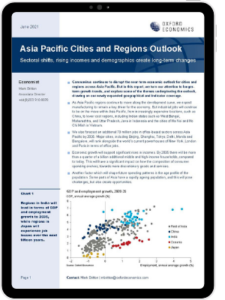APAC Cities Outlook | Sectoral shifts, rising incomes and demographics create long-term changes

Over the past twenty years parts of Asia Pacific have experienced some of the fastest economic growth globally. This trend is set to continue over the next fifteen years, with China and India continuing to lead Asia’s contribution to world GDP. In our latest APAC Cities and Regions Outlook, we explore some of the themes underpinning the outlook.
What you will learn:
- Sectoral shifts: As China transitions towards higher value, less labour-intensive manufacturing, there are opportunities for other lower wage Asian regions to take its place. We believe India and Indonesia are set to become Asia’s new industrial powerhouses.
- Rising income: Long-term economic growth will support rising incomes, helping millions of households move out of poverty and up through the income bands. Across the Asia Pacific region, there will be over 210 million additional middle-income households by 2035 compared to 2020.
- Ageing population: Ageing populations will pose challenges such as rising pension and healthcare costs, there will also be significant opportunities associated with the rise of the “silver economy”
If you would like to get access to our forecasts for 47 cities and sub regions in Asia Pacific, click here to submit a free trial request.

Tags:
Related Services

Post
Food prices to bottom out in 2024, risks skewed to upside
Our baseline forecast is for world food commodity prices to register an annual decline this year, in aggregate, reducing pressure on food retail prices further downstream. However, we believe the risks to this forecast are overwhelmingly skewed to the upside.
Find Out More
Post
Battery raw material prices to recover
Battery raw materials prices bottomed out last quarter and we think a sustained recovery is looming. Midstream EV battery manufacturing activity has picked up again and inventories have returned to historical levels, suggesting upstream demand for raw materials will also bounce back.
Find Out More